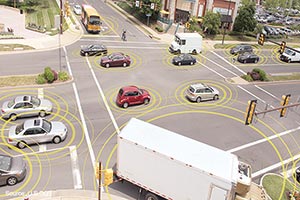Senior Reporter
DOT Announces Proposed Rule for Vehicle-to-Vehicle Communication

The U.S. Department of Transportation on Dec. 13 issued a proposed rule offering guidance for the development of vehicle-to-vehicle technologies that would provide advance warning of potentially life-threatening crashes for light vehicles.
Although the proposal did not include heavy trucks, Transportation Secretary Anthony Foxx said during a telephone news conference that the light vehicle guidance could pave the way for a later adoption of guidance for heavy trucks.
“Today‘s announcement is the next step in our march toward capturing the opportunities and safety advantages of new technologies,” Foxx said. “The proposal I’m announcing would allow new light vehicles to be equipped with technology to enable them to communicate effectively with each other while on the road. This technology has enormous safety potential to prevent hundreds of thousands of crashes and save lives.”
The V2V technology would share data in a common language for such variables as a vehicle’s speed, direction and position at a rate of 10 times per second, Foxx said. The technologies would provide 360-degree awareness and include such systems as automatic emergency braking for adaptive cruise control to automatically avoid or lessen imminent crashes.
Foxx estimated it could be up to five years before compliance of a final rule would take effect.
Mark Rosekind, administrator of the National Highway Transportation Safety Administration, said the wireless technology would be include 128-bit encryption that would protect vehicles from being hacked.
“This is a safety tool, not a data-gathering tool,” he said.
Rosekind said that heavy-truck V2V technology is still in the research stage.
“But we know that the benefits we’re seeing in the light vehicles clearly would generalize to heavy vehicles and trucks as well,” Rosekind said. “It took us 12 years to get here and hopefully we’ll be able to do it faster with all the light vehicle work. But the research for trucks and heavy vehicles is going on right now.”
“One has to think of all this as building blocks,” Foxx added. “What we do with light vehicles adds a cornerstone to what we can do with other surface modes. This rule provides a foundation for hopefully evolution in how we approach other modes such as trucks.”
Meanwhile, transportation policymakers from the western part of the United States intend to push measures aimed at crafting regulatory uniformity on autonomous trucks, Jay Hicks, president of the Western States Transportation Alliance, said on Dec. 10.
The recent test-runs of autonomous and semi-autonomous trucks around the country have prompted calls by lawmakers and stakeholders for establishing a regional and, eventually, a national set of rules for the industry.
“One of our goals, at WSTA, is to look at regulations and things that we can do,” Hicks said at his group’s annual summit in Denver, Colorado.
In October, a self-driving truck developed by Otto, a subsidiary of Uber Technologies Inc., hauled a load of Budweiser beer about 120 miles on Interstate 25 in Colorado. The following month, a semi-autonomous truck, also operated Otto, traveled on highways in Ohio. The Buckeye State announced a $15 million investment in smart infrastructure to test automated vehicles.
Additional reporting by Eugene Mulero

